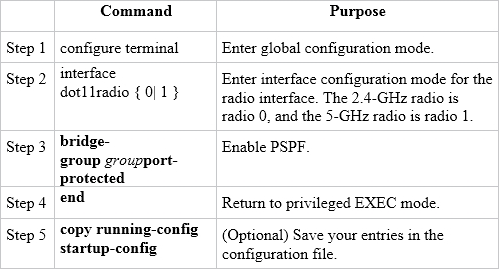Two wireless IP phones are never able to call each other when connected to the same autonomous AP. However, they can place calls to other wireless IP phones that are connected to other APs or to wired IP phones. The wireless phones are operating on VLAN100.
Based on this output, which statement about the problem is true?
ap(config-subif)#do show run interface do 0.100
Building configuration…
Current configuration: 320 bytes
!
interface Dot11Radio1.100
encapsulation dot1Q 100
no ip route-cache
bridge-group 100
bridge-group 100 subscriber-loop-control
bridge-group 100 port-protected
bridge-group 100 block-unknown-source
no bridge-group 100 source-learning
no bridge-group 100 unicast-flooding
bridge-group 100 spanning-disabled
end
A . P2P blocking is enabled via the no bridge-group 100 unicast-flooding command.
B . P2P blocking is enabled via the bridge-group 100 block-unknown-source command.
C . P2P blocking is enabled via the bridge-group 100 subscriber-loop-control command.
D . P2P blocking is enabled via the no bridge-group 100 source-learning command.
E . P2P blocking is enabled via the bridge-group 100 port-protected command.
Answer: E
Explanation:
Public Secure Packet Forwarding (PSPF) prevents client devices associated to an access point from inadvertently sharing files or communicating with other client devices associated to the access point. It provides Internet access to client devices without providing other capabilities of a LAN. This feature is useful for public wireless networks like those installed in airports or on college campuses.
![]()
Note To prevent communication between clients associated to different access points, you must set up protected ports on the switch to which the wireless devices are connected. See the "Configuring Protected Ports" section for instructions on setting up protected ports.
To enable and disable PSPF using CLI commands on the wireless device, you use bridge groups. You can find a detailed explanation of bridge groups and instructions for implementing them in this document:
• Cisco IOS Bridging and IBM Networking Configuration Guide, Release 12.2. Click this link to browse to the Configuring Transparent Bridging chapter: http://www.cisco.com/univercd/cc/td/doc/product/software/ ios122/122cgcr/fibm_c/bcfpart1/bcftb.htm You can also enable and disable PSPF using the web-browser interface. The PSPF setting is on the Radio Settings pages. PSPF is disabled by default. Beginning in privileged EXEC mode, follow these steps to enable PSPF:

http://www.cisco.com/c/en/us/td/docs/wireless/access_point/12-3_8_JA/configuration/guide/1238jasc/ s38rf.html#wp1038494

Leave a Reply